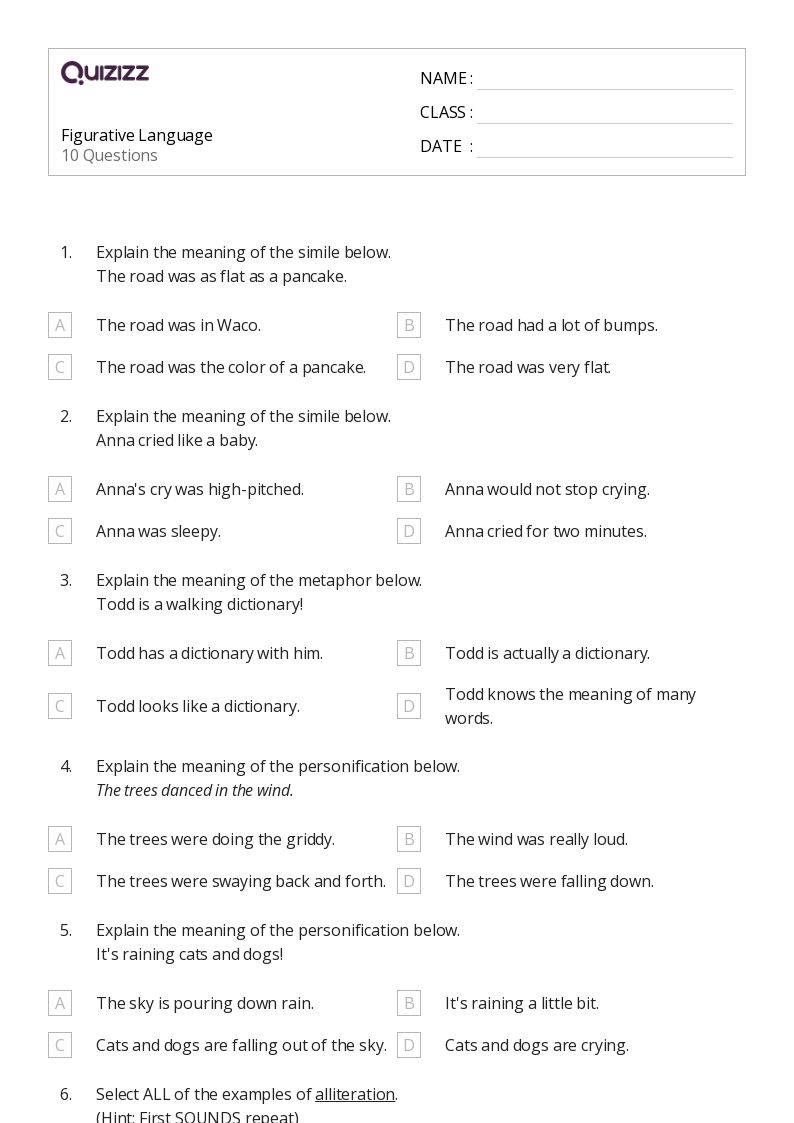Figurative Language Worksheet 3
Figurative Language Worksheet 3 - It was raining cats and dogs, so i rode the bus. Four sides and 27 problems! Designed for third and fourth graders, this worksheet is a fun way to help students understand and differentiate between types of figurative language. Figure out which technique is being used: Students determine whether each snippet contains an example of simile, metaphor,. Featuring eight excerpts from literary texts, all of which feature different types of figurative language, this worksheet gives students a chance to study real examples of verbal irony,.
This exercise will get your students inferring the meaning of unknown. It was raining cats and dogs, so i rode the bus. Students will learn to identify and interpret. Featuring eight excerpts from literary texts, all of which feature different types of figurative language, this worksheet gives students a chance to study real examples of verbal irony,. Read the lines of poetry.
Figurative language worksheet 3 directions: Master figurative language with worksheet 3! Designed for third and fourth graders, this worksheet is a fun way to help students understand and differentiate between types of figurative language. Read the lines of poetry. (some of the sentences have no figurative language at all, so stay on your toes!) 1.
Figurative language is used to mean something other than what is written, something symbolic, suggested, or implied. What kind of imagery predominates? Read the lines of poetry. It is possible more than. Explore similes, metaphors, personification, and more in this engaging educational resource.
This exercise will get your students inferring the meaning of unknown. Ideal for fourth and fifth graders, this worksheet includes figurative language examples and definitions on the first page, and a second full page of questions and tasks that can be used to. Identify what type of figurative language is being used in each sentence. Idiom, simile, metaphor, hyperbole, or.
Ideal for fourth and fifth graders, this worksheet includes figurative language examples and definitions on the first page, and a second full page of questions and tasks that can be used to. This exercise will get your students inferring the meaning of unknown. Idiom, simile, metaphor, hyperbole, or personification. Figurative language is used to mean something other than what is.
Teach your students the different types of figurative languages and have them practice every day during english. Identify what type of figurative language is being used in each sentence. It was raining cats and dogs, so i rode the bus. Ideal for fourth and fifth graders, this worksheet includes figurative language examples and definitions on the first page, and a.
Figurative Language Worksheet 3 - Explore similes, metaphors, personification, and more in this engaging educational resource. Contains over 20 figures of speech from classic poems and stories and asks students to identifying the examples of. It was raining cats and dogs, so i rode the bus. Teach your students the different types of figurative languages and have them practice every day during english. Figure out which technique is being used: It is possible more than.
Read the lines of poetry. Metaphor, simile, personification, hyperbole, alliteration, onomatopoeia, & more. Figurative language is used to mean something other than what is written, something symbolic, suggested, or implied. Explore similes, metaphors, personification, and more in this engaging educational resource. What kind of imagery predominates?
Ideal For Fourth And Fifth Graders, This Worksheet Includes Figurative Language Examples And Definitions On The First Page, And A Second Full Page Of Questions And Tasks That Can Be Used To.
Contains over 20 figures of speech from classic poems and stories and asks students to identifying the examples of. This worksheet is an overview of the most common types of figurative language and includes metaphors, personification, similes, alliteration, idioms, hyperbole, puns, repetition,. Explore similes, metaphors, personification, and more in this engaging educational resource. Featuring eight excerpts from literary texts, all of which feature different types of figurative language, this worksheet gives students a chance to study real examples of verbal irony,.
It Was Raining Cats And Dogs, So I Rode The Bus.
Figure out which technique is being used: Students determine whether each snippet contains an example of simile, metaphor,. Identify what type of figurative language is being used in each sentence. Idiom, simile, metaphor, hyperbole, or personification.
Use This Resource With Your Students To Practice Using Context Clues To Determine The Meaning Of Figurative Language.
What kind of imagery predominates? Sample sensory images and figures of speech in the description of the hurricane: Teach your students the different types of figurative languages and have them practice every day during english. Figurative language is used to mean something other than what is written, something symbolic, suggested, or implied.
Master Figurative Language With Worksheet 3!
This exercise will get your students inferring the meaning of unknown. Read the lines of poetry. Figurative language worksheet 3 directions: It is possible more than.




